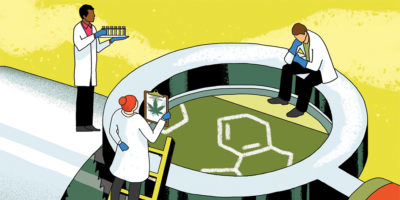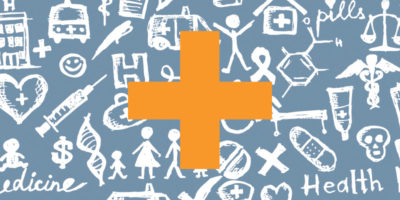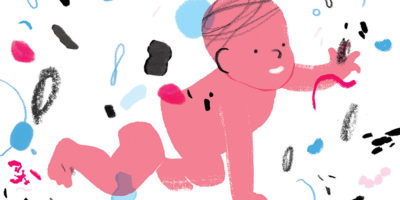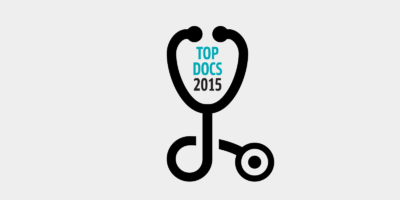Gretchen Sims couldn’t get to sleep at night. A diligent Towson University freshman, she’d spend her lonely, insomnia-filled hours doing her homework, inevitably falling asleep in classes the next day. Despite completing her assignments, professors assumed she was either uninterested in the lecture material or wrung out from late-night partying — not uncommon for college students.
She’d taken AP classes in high school, played volleyball, sung in the choir, and worked during the summer, and she wanted to pursue vigorous academic and extracurricular activities in college, too. But she struggled now merely to function each day. “If I went to hang out in a friend’s dorm, went to the library or a movie with a group of people, I was always the person that fell asleep,” she says. “The things I wanted to do, I wasn’t engaged in them—I was too tired or couldn’t focus.”
She did okay academically as a freshman, but her sleeping woes worsened. That summer, at home, she’d often be up all night and then doze off for 10 hours into the middle of the day. Still not refreshed, however. Then, during her sophomore year, she suddenly fell into a state of paralysis in front of schoolmates at Towson’s Albert S. Cook Library—fully conscious, but unable to move, her face muscles slackening completely as her iced tea fell to the ground beside her chair. She revived a few minutes later, groggy and unsure what had happened. Her friends, she says, convinced her that she needed “to get that checked out.”
Eventually, Sims landed the University of Maryland Sleep Disorders Center in downtown Baltimore—“in a room that looked somewhere between a nice dorm and a hotel”—hooked up to an array of electrodes and equipment designed to measure everything from her cardiovascular and respiratory systems to her brain waves while she slept. That first overnight ruled out sleep apnea—an interruption in her breathing—as the cause of her problems. But a subsequent daytime follow-up visit during which she took five naps (sleep lab visits are also videotaped and monitored by technicians), revealed the then-19-year-old suffered from narcolepsy, a potentially devastating chemical and biological disorder in the brain. During her naps, for example, Sims fell into deep REM sleep in less than five minutes, when it typically takes people about an hour and a half to do so each night. This interrupts her normal, restorative nighttime sleep cycles in addition to creating uncontrollable daytime sleep episodes. The sudden bouts of waking paralysis that Sims experiences, known as cataplexy, are found in about 70 percent of narcolepsy sufferers.
“My biggest problem is that I can’t get a driver’s license. That’s just something I’m going to have to learn To live with.”
“It was a great relief to get diagnosed,” says Sims, who takes a regimen of medication, including amphetamine-based Adderall and anti-depressants, designed to keep her awake during the day. Two years later, she still meets with Dr. Steven M. Scharf, who founded the University of Maryland sleep center a dozen years ago, on a semi-regular basis. “Since I’ve been diagnosed, I meet with my professors before each semester, and I’ve been able to receive accommodations at school, like getting extra time for assignments. I also get time and a half to take my exams, which are monitored by a proctor, in case I fall asleep.” Meanwhile, her grades have improved and she hopes to graduate this spring and then pursue a master’s degree in occupational therapy.
“My biggest problem is that I can’t get a driver’s license,” says Sims. “That’s just something I’m going to have to learn to live with. Or rather, live without.”
Sims, in fact, is lucky in one regard. University of Maryland researcher and clinician Jeanne Geiger-Brown notes she has several narcolepsy patients for whom the disorder is so prominent that they are unable to work at all, forced to live on disability income. “It’s sad, really,” Geiger-Brown says. “Their lives are severely compromised, unable to sleep in normal cycles, they are exhausted all the time.”
Thankfully, narcolepsy, whether manageable, as in Sims’s case, or of the more profound variety, remains a relatively rare condition, affecting an estimated one in every 3,000 people. Today, the majority of patients at Maryland’s sleep disorder clinic present with sleep apnea, even more so than insomnia. But all chronic sleep pattern disruptors, researchers are now learning, don’t merely produce what we think of as classic slumber-deprived symptoms such as irritability and an inability to concentrate. Insomnia has been linked to weight gain, hypertension, and depression. Sleep apnea, in particular, if untreated, can drive a plethora of long-term, potentially dire physical health consequences, increasing the risk for high blood pressure, Type 2 diabetes, cancer, stroke, heart attack, and even sudden-death cardiac arrest—which killed former NFL All-Pro Reggie White at age 43.
In fact, all sorts of bad things begin to happen as a result of sleep apnea.
“For 20 years, all anyone has been talking about, in terms of improving health, is diet and exercise,” says Scharf. “No one has been talking about sleep, which is at least as important to good health as either one of those.”
The University of Maryland Sleep Disorders Center, which recently moved into a new wing at the school’s midtown campus, includes eight beds, and logs about 150 sleep studies a month in its lab. The clinic side of the center, in which physicians and counselors meet with patients one-on-one to discuss treatment and ongoing issues, also sees between 120 and 150 patients a month.
A Ph.D. and researcher as well as an M.D., Scharf has been especially interested in the cardiovascular effects of sleep-disordered breathing. Though many cases go undiagnosed, an estimated 18 million Americans have obstructed sleep apnea, enduring brief and repeated interrupted sleep for anywhere from 10 seconds to a couple of minutes, sometimes 30 times or more an hour, when the muscles in the back of the throat fail to keep the airway open. Doctors can’t detect the condition during routine office visits, and there’s no blood test to diagnose the condition. Usually, it’s a family member or partner who first notices signs of sleep apnea because of the loud snoring that typically takes place as air struggles to squeeze past the blockage.
Scharf, whose initial medical focus was in pulmonary and critical-care medicine, shifted to the study (and treatment) of the effects of sleep on health, as the inexorable link between the two became more and more apparent. “We’ve always known that obesity is associated with heart problems and high blood pressure, but now what we’ve learned is that there is a mechanism related to poor sleep, where apnea, the interruption in breathing, causes a drop in oxygen levels in the blood,” Scharf says. “When sleep apnea has been induced in rats and mice, we can track the damage down to the chambers in their hearts.”

Dr. Steven M. Scharf, who founded the University of Maryland Sleep Disorders Center a dozen years ago.
In fact, Scharf says, all sorts of bad things begin to happen as a result of sleep apnea, including the release of stress hormones and inflammatory chemicals. “Blood pressure rises, the heart walls thicken, and there’s measureable, immediate effects in brain function,” he says. “With mice, who’ve learned how to swim to a place where they can stand in the water—they won’t be able to recall where the dock is stationed. They literally have to start their search all over.”
The most common cause of obstructive apnea is obesity, a growing epidemic in the U.S., which leads to an increase in the soft tissue of the mouth and throat, blocking the airway when throat and tongue muscles are more relaxed—as they are during sleep. Increased childhood obesity is also driving a dramatic increase in apnea among kids, with a Centers for Disease Control study reporting a 436 percent increase in the number of hospital discharges for sleep apnea among children over the last 20 years. (The University of Maryland Sleep Disorders Center includes two pediatric beds.)
But not all sleep apnea problems are related to obesity. Some have to do more with the genetic shape of the mouth and throat—or tonsils and adenoids in children. Also, simply size and weight, not necessarily fat, can create problems. When a person with a large chest and upper body, like an NFL lineman such as White, lies down, the sheer weight can cause a downward pressure on the narrow passages of the upper respiratory areas.
Baltimore Ravens’ tackle Ryan Jensen, cut after a disappointing training camp this summer, was eventually resigned to the practice squad after being diagnosed with sleep apnea. “Looking back, it probably started about two years ago,” says Jensen, adding that Ravens director of player development Harry Swayne had noticed a change in his behavior, as well as his performance, during training camp and helped set up an overnight visit to the Greater Baltimore Medical Center’s Sleep Center in Towson. “Part of is that you’re groggy and irritable, and then, in terms of football, the other thing is that your body isn’t recovering from the workouts.”
Following his sleep study, Jensen learned that he stopped breathing for as long as 35 seconds at some points, suffering from as many as 90 breathing episodes a night, while waking up close to 30 times in the course of a single evening. He now uses a Continuous Positive Airway Pressure (CPAP) machine and mask—the standard treatment for sleep apnea—which pumps a flow of air into the nasal passages to keep them open. “In terms, of my overall health, this is something that I’ve learned could have potential devastating effects. The way I look at it, getting this diagnosed and treated will save my life.”
Beyond apnea, narcolepsy, and a number of other less common sleep issues, such as restless leg syndrome and sleepwalking—not rare, but generally not dangerous—insomnia brings many clients to sleep centers at area hospitals. Geiger-Brown says that insomnia episodes typically begin as an event-driven phenomena—anxiety or stress related to a particular life situation. “Insomnia affects about 30 percent of the population, who have either difficulty falling asleep, or staying asleep, or both,” says Geiger-Brown, a University of Maryland Ph.D., who also studied adult psychiatric and mental health nursing at Columbia University. “For a small percentage, three percent, there is a primary psychiatric diagnosis, but for most people it stems from something else—a divorce, financial difficulties, a job crisis, or a medical issue.” Generally, she says, the insomnia disappears when the life situation gets resolved, but not always.
“We don’t focus on the underlying issues, but changing sleep behavior—what we refer to as ‘sleep hygiene,’” she says. “That starts with getting up at the same time every day and going to bed at the same time every night.” Other good sleep hygiene habits, Geiger-Brown says, include making sure that the bedroom and bed are only used for “sleeping and sex.”
“No TV, working, or eating in the bedroom,” she says. “And definitely no computer or smartphone use. Surfing the Internet or engaging with social media—that’s even worse than television, which is more passive.” Even reading in bed isn’t encouraged. “You don’t want anything that’s sending input to the brain,” Geiger-Brown says. “You want the brain to be winding down.” She notes that light—particularly the blue light of electronic screens—keeps sleepiness at bay by inhibiting the natural release of melatonin in the brain. It’s a particular challenge for teenagers today, she says, noting that they require more sleep to begin with than adults and start their school days early. “But we see people from all walks of life,” Geiger-Brown says. “I had a guy, a public servant in his early 50s, whose name you would know, to truck drivers and nurses. We see a lot of people in service and transportation industries who work off-hour schedules and changing schedules, which create real challenges.”
“I have a stressful job and when I lie down, it’s ‘Start your engines’ time.”
According to Geiger-Brown, exercise is helpful in combatting insomnia, as is a well-balanced meal, so long as neither occur too close to bedtime. Sometimes, she admits, even the best treatments and sleep hygiene routines can only manage sleeping problems without completely eliminating them, as is the case with Gretchen Sims. Naps can assist in eliminating symptoms of sleepiness, as long as they’re in the 20-30 minute range and not longer, which could interfere with falling asleep at night. Both Scharf and Geiger-Brown say they are neither pro- nor anti-sleeping pills, which they will prescribe, but they say sleeping pills lose effectiveness over time and are not a long-term solution.
One state employee, who works in the Department of Health and Mental Hygiene and did not want her real name used, says she finally visited the University of Maryland Sleep Disorders Center recently, after dealing with insomnia for years, and learned she suffers from mild sleep apnea as well.
“The insomnia started in my mid- to late- 40s when I found myself unable to sleep, roaming around at night, and I remember thinking it was menopause, a biological thing,” she says. “I tried Ambien and a variety of things, but nothing worked for long.
“I have a stressful job and when I lie down, it’s ‘Start your engines’ time,” she says, explaining that her mind starts racing about her next day’s to-do list and general anxiety.
She has tried white-noise machines and, eventually, has settled into watching TV, mostly sitcom re-runs or late-night talk shows—nothing potentially disturbing, in other words. But she hasn’t committed to trying a CPAP mask, yet, despite knowledge of the potential health consequences, and she’s not sure she’s ready to give up her self-medicating television viewing, either.
“I have a hard time letting go, that’s part of the problem,” she says. “I do have a timer that turns the TV off, and there’s no smartphone in the bedroom. Dr. Geiger-Brown has also suggested that I intentionally shorten my sleep on the weekend, when I normally sleep in, to help me get on a regular schedule, but I haven’t been able to do that. I’m still working on ‘Sleep Hygiene 101.’”























